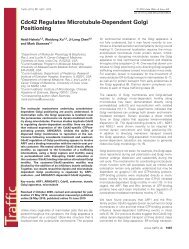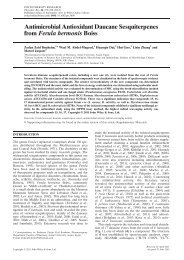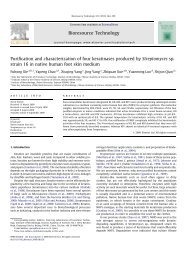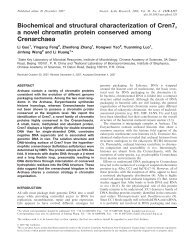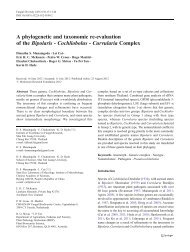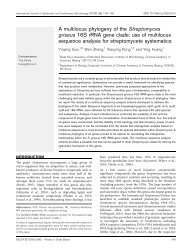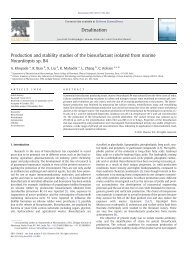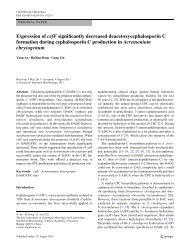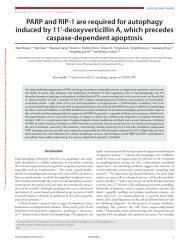Structure and Cleavage Specificity of the Chymotrypsin-Like Serine ...
Structure and Cleavage Specificity of the Chymotrypsin-Like Serine ...
Structure and Cleavage Specificity of the Chymotrypsin-Like Serine ...
You also want an ePaper? Increase the reach of your titles
YUMPU automatically turns print PDFs into web optimized ePapers that Google loves.
ARTICLE IN PRESS<br />
4 <strong>Structure</strong> <strong>and</strong> Characterization <strong>of</strong> PRRSV 3CLSP<br />
Table 1. Data collection <strong>and</strong> refinement statistics<br />
Native protein<br />
S118A mutant<br />
Data collection<br />
Space group C2 C2<br />
Cell dimensions<br />
a, b, c (Å) 112.4, 49.2, 42.9 113.3, 48.6, 42.9<br />
α, β, γ (°) 90.0, 110.3, 90.0 90.0, 110.4, 90.0<br />
SeMet multiple-wavelength<br />
anomalous dispersion<br />
Native Peak Remote<br />
Wavelength (Å) 1.5418 0.9793 0.9000 1.5418<br />
Resolution range (Å) 32.3–1.9 53.0–1.9 50.0–2.0 44.19–2.01<br />
a,b<br />
R merge 0.045 (0.167) 0.213 (0.459) 0.123 (0.216) 0.049 (0.169)<br />
Average I/σ(I) a 22.1 (4.3) 12.5 (1.4) 10.1 (2.4) 47.1 (11.8)<br />
Completeness (%) a 95.2 (91.6) 95.7 (77.6) 89.8 (75.7) 98.9 (96.3)<br />
Redundancy 4.5 (4.3) 4.5 (3.4) 2.4 (2.0) 5.2 (4.8)<br />
Refinement<br />
R cryst /R free (%) c 19.6/24.6 18.2/21.5<br />
Ramach<strong>and</strong>ran plot (%) d<br />
Most favored regions 89.5 90.2<br />
Additionally allowed regions 10.5 9.8<br />
Generously allowed regions 0 0<br />
Disallowed regions 0 0<br />
r.m.s.d. from ideality<br />
Bonds (Å) 0.017 0.018<br />
Angles (°) 1.572 1.529<br />
Average B-factor (Å 2 )<br />
Protein 19.933 28.120<br />
Water 36.572 37.980<br />
a Values for <strong>the</strong> outermost resolution shell are given in paren<strong>the</strong>ses.<br />
b R merge =∑ i ∑ hkl │ I i −〈I〉│/∑ i ∑ hkl I i , where I i is <strong>the</strong> observed intensity <strong>and</strong> 〈I〉 is <strong>the</strong> average intensity from multiple measurements.<br />
c R cryst =∑ ││F o │ −│ F c ││/∑│ F o │, where F o <strong>and</strong> F c are <strong>the</strong> structure-factor amplitudes from <strong>the</strong> data <strong>and</strong> <strong>the</strong> model, respectively. R free<br />
is <strong>the</strong> R-factor for a subset (5%) <strong>of</strong> reflections that was selected prior to refinement calculations <strong>and</strong> was not included in <strong>the</strong> refinement.<br />
d Ramach<strong>and</strong>ran plots were generated by using <strong>the</strong> program PROCHECK.<br />
A Dali search 19 <strong>of</strong> <strong>the</strong> Protein Data Bank (PDB)<br />
database gave a variety <strong>of</strong> proteins with significant<br />
structural similarities to our structure, among which<br />
<strong>the</strong> EAV nsp4 expectedly had <strong>the</strong> highest Z score<br />
(21.7). As <strong>the</strong> prototype structure <strong>of</strong> nsp4s in<br />
Arteriviridae, <strong>the</strong> EAV 3CLSP also folds into three<br />
domains. 12 Superposing domains I <strong>and</strong> II <strong>of</strong> PRRSV<br />
3CLSP onto those <strong>of</strong> <strong>the</strong> EAV nsp4 (copy A <strong>of</strong> <strong>the</strong> four<br />
copies in <strong>the</strong> asymmetric unit) yielded an r.m.s.d. <strong>of</strong><br />
2.04 Å for 122 equivalent (out <strong>of</strong> 134 compared) C α<br />
pairs (Fig. 3a), while domain III alone exhibited an r.<br />
m.s.d. <strong>of</strong> 0.52 Å for 30 (out <strong>of</strong> 38) C α pairs (Fig. 3d),<br />
indicating that <strong>the</strong> two enzymes share great structural<br />
similarity at <strong>the</strong> tertiary level. However, <strong>the</strong> steric<br />
arrangement <strong>of</strong> <strong>the</strong> domains in <strong>the</strong> two proteases is<br />
quite different. An ∼8 Å shift <strong>of</strong> domain III relative to<br />
domains I <strong>and</strong> II was observed in our structure, when<br />
compared to EAV nsp4. This shift causes <strong>the</strong> whole<br />
domain III to move away from <strong>the</strong> cleft where <strong>the</strong><br />
catalytic triad is located (Fig. 3a). Clear electron<br />
density for <strong>the</strong> loop Asn153-Ile157 that connects<br />
domains II <strong>and</strong> III, as shown in Fig. 3c, leaves no<br />
doubt about <strong>the</strong> chain tracing <strong>of</strong> <strong>the</strong> loop <strong>and</strong> verifies<br />
<strong>the</strong> 8-Å shift <strong>of</strong> domain III, compared to EAV nsp4.<br />
The shift may also account for our failure to solve <strong>the</strong><br />
structure by MR using EAV nsp4 as <strong>the</strong> search model.<br />
Fur<strong>the</strong>r discrepancies were also observed in two<br />
loop regions. One is <strong>the</strong> loop connecting str<strong>and</strong>s cII<br />
<strong>and</strong> dII (Cys111-Pro121 in PRRSV nsp4). In EAV<br />
nsp4, this loop is much like a tadpole with its head<br />
lying next to <strong>the</strong> catalytic nucleophile Ser120 (Fig.<br />
3b). However, <strong>the</strong> corresponding loop in our<br />
structure is approximately “⨼” shaped with a<br />
protuberance pointing to domain III (Fig. 3a <strong>and</strong> b)<br />
on which <strong>the</strong> hydrophobic side chain <strong>of</strong> Phe112<br />
resides. This residue is conserved in PRRSV <strong>and</strong><br />
lactate dehydrogenase-elevating virus 3CLSP but<br />
not in EAV nsp4, where it is substituted by Trp (Fig.<br />
2c). The phenyl ring <strong>of</strong> Phe112 protrudes into <strong>the</strong><br />
hydrophobic interface between domains II <strong>and</strong> III<br />
(Fig. 5a, left image) <strong>and</strong> <strong>the</strong>reby causes <strong>the</strong> “⨼”-<br />
shaped conformation <strong>of</strong> <strong>the</strong> cII–dII loop.<br />
Ano<strong>the</strong>r loop <strong>of</strong> great variance is <strong>the</strong> one connecting<br />
str<strong>and</strong>s eII <strong>and</strong> fII. In PRRSV 3CLSP, this loop is<br />
eight residues in length, from Gly135 to Gly142, <strong>and</strong><br />
is highly flexible as proved by <strong>the</strong> total lack <strong>of</strong><br />
electron density for residues 136–140. However, in<br />
EAV nsp4, <strong>the</strong> corresponding region is mainly a β-<br />
str<strong>and</strong> with a much shorter loop, indicating that <strong>the</strong><br />
conformation <strong>of</strong> this part is relatively rigid (Fig. 3b).<br />
Interestingly <strong>the</strong>se two regions showing significant<br />
variance are actually believed to cover, respectively,<br />
<strong>the</strong> S1 specificity pocket <strong>and</strong> <strong>the</strong> oxyanion<br />
hole in EAV nsp4, 12 two highly important features<br />
involved in substrate recognition <strong>and</strong> catalysis by<br />
3CL proteases.<br />
The S1 specificity pocket<br />
In 3CL proteases, <strong>the</strong> S1 specificity pocket<br />
accommodates <strong>the</strong> side chain <strong>of</strong> <strong>the</strong> substrate P1<br />
residue <strong>and</strong> <strong>the</strong>refore determines <strong>the</strong> enzyme's<br />
Please cite this article as: Tian, X., et al., <strong>Structure</strong> <strong>and</strong> <strong>Cleavage</strong> <strong>Specificity</strong> <strong>of</strong> <strong>the</strong> <strong>Chymotrypsin</strong>-<strong>Like</strong> <strong>Serine</strong> Protease (3CLSP/nsp4)<br />
<strong>of</strong> Porcine Reproductive <strong>and</strong> Respiratory Syndrome Virus (PRRSV), J. Mol. Biol. (2009), doi:10.1016/j.jmb.2009.07.062





